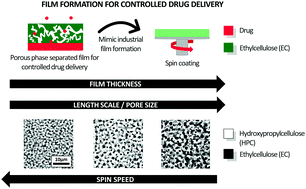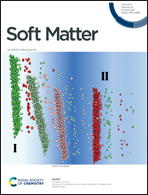Structure evolution during phase separation in spin-coated ethylcellulose/hydroxypropylcellulose films
Abstract
Porous phase-separated films made of ethylcellulose (EC) and hydroxypropylcellulose (HPC) are commonly used for controlled drug release. The structure of these thin films is controlling the drug transport from the core to the surrounding liquids in the stomach or intestine. However, detailed understanding of the time evolution of these porous structures as they are formed remains elusive. In this work, spin-coating, a widely applied technique for making thin uniform polymer films, was used to mimic the industrial manufacturing process. The focus of this work was on understanding the structure evolution of phase-separated spin-coated EC/HPC films. The structure evolution was determined using confocal laser scanning microscopy (CLSM) and image analysis. In particular, we determined the influence of spin-coating parameters and EC : HPC ratio on the final phase-separated structure and the film thickness. The film thickness was determined by profilometry and it influences the ethanol solvent evaporation rate and thereby the phase separation kinetics. The spin speed was varied between 1000 and 10 000 rpm and the ratio of EC : HPC in the polymer blend was varied between 78 : 22 wt% and 40 : 60 wt%. The obtained CLSM micrographs showed phase separated structures, typical for the spinodal decomposition phase separation mechanism. By using confocal laser scanning microscopy combined with Fourier image analysis, we could extract the characteristic length scale of the phase-separated final structure. Varying spin speed and EC : HPC ratio gave us precise control over the characteristic length scale and the thickness of the film. The results showed that the characteristic length scale increases with decreasing spin speed and with increasing HPC ratio. The thickness of the spin-coated film decreases with increasing spin speed. It was found that the relation between film thickness and spin speed followed the Meyerhofer equation with an exponent close to 0.5. Furthermore, good correlations between thickness and spin speed were found for the compositions 22 wt% HPC, 30 wt% HPC and 45 wt% HPC. These findings give a good basis for understanding the mechanisms responsible for the morphology development and increase the possibilities to tailor thin EC/HPC film structures.



 Please wait while we load your content...
Please wait while we load your content...